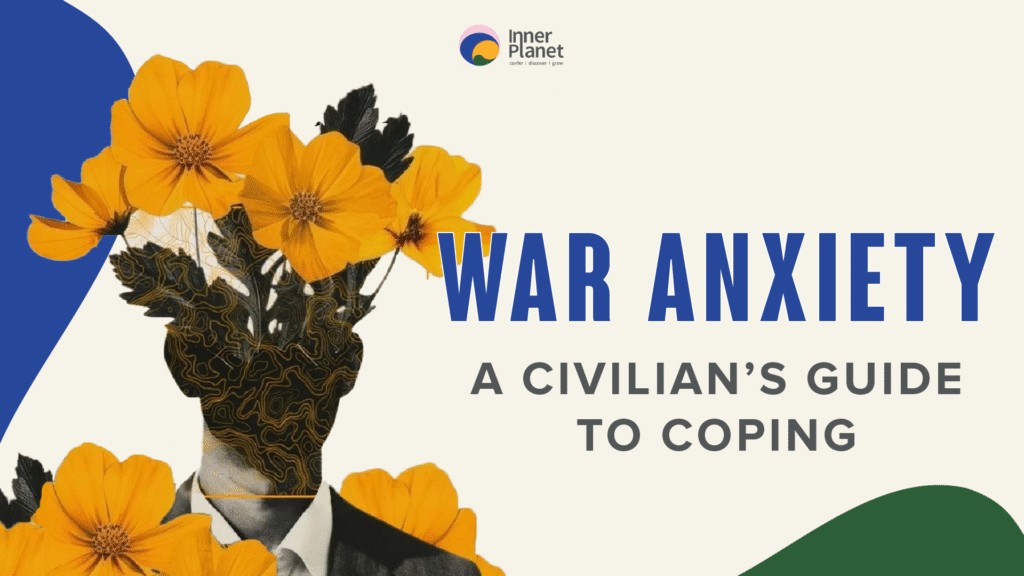War anxiety isn’t limited to the brave soldiers defending the front lines. Civilians—ordinary people just trying to live their lives—often carry invisible psychological wounds that can linger long after the last gunshot echo fades. With recent tensions in the Indian subcontinent once again making headlines, it’s natural for many across the region to feel unsettled, afraid, or overwhelmed. If that’s you, please know that you’re not alone.
In times like these, mental health care becomes more important than ever—not just for ourselves, but so we can be present and supportive for the people we love. So, let’s take a closer look at what war anxiety really is, and explore simple, effective ways to cope with it.
1. What Happens to the Mind in Times of War?
During conflict, it’s not just the noisy explosions and heartbreaking deaths that weigh us down—it’s about surviving every uncertain moment in between. The fear when the phone rings. The dread with every news alert. The ache of unpredictability that settles in your chest. These aren’t overreactions—they’re deeply human responses to the psychological trauma triggered by such conflict.
If you’ve been feeling jumpy, constantly worried, low on energy, or unable to focus, you’re not “weak” or “overreacting.” These are common—even expected—effects of living under the threat of war. Research shows that nearly 4 in 10 civilians exposed to such conditions develop persistent anxiety—feelings of restlessness, nervousness, or unease that don’t easily go away (Lim et al., 2022). Others experience depression, which might show up as a loss of motivation or feeling numb. Some also live with symptoms similar to PTSD—haunted by nightmares or flashbacks, or always on alert as if danger is around the corner (Lim et al., 2022; Murthy & Lakshminarayana, 2006).
And it’s not the same for everyone. Women, children, and people from marginalised communities often face greater emotional burdens, especially when they’ve been displaced or lost loved ones (Amsalem et al., 2025; Khalil et al., 2024). What you’re feeling makes sense. It’s your mind’s way of saying: “Something terrible is happening—and I’m trying to protect you, the only way I know how.
2. How to Cope with War Anxiety
So, let’s experiment with better ways to cope! When everything around feels insecure, like it’s slipping away, even the smallest act of care can become a lifeline. War anxiety doesn’t necessarily look dramatic—it might show up as a constant ache in your chest that unexpectedly tightens, difficulty sleeping, or an invisible tension you carry—like clenching your jaw without even realising it.
If that’s where you are right now, you’re not alone—and you don’t have to face this without support. Here are some methods you can use to relieve yourself:
- Stay Informed, Avoid Overload: It’s natural to want to stay updated. But constant exposure to distressing news can exhaust your mind. Choose one or two reliable sources, set limits on how often you check, and let yourself unplug. Your brain—and your heart—deserve a break.
- Build Small Anchors in Your Day: War can disrupt every part of life. That’s why small, familiar routines matter so much. Drinking tea at the same time each morning. Taking five minutes to write down your thoughts. These may seem silly but they’re powerful anchors that remind your nervous system that not everything is out of your control.
- Use Your Breath to Come Back to the Present: Mindfulness isn’t designed to escape what’s going on. It’s about consciously returning your attention to the affairs of now, especially when fear pulls you into worst-case scenarios. Something as simple as noticing your breath or naming five things around you can interrupt spirals of panic. These simple techniques have brought relief to many civilians dealing with trauma, even in active conflict settings (Jeebodh-Desai & Dwarika, 2022).
- Let Movement Ease the Pressure: When your body holds fear for too long, it aches. Light stretching, walking, or even dancing around your room—just let it loose!—can help release some of that tension. It doesn’t need to be perfect. Just moving, in any way that feels safe, tells your body it’s okay to let go (Hoppen & Morina, 2020).
- Speak It Out: Talking helps, even if you’re not sure what to say. Whether it’s with a close friend, a relative, or someone in your community, expressing what you’re going through lightens the emotional load. You’re not “too much,” and your pain is not a burden. And if you’re concerned about taking up too much space, remember: doing this will allow you to hold space for your loved ones too.
- Understand What You’re Feeling: Sometimes, just knowing that your reaction is normal can be healing. This is called psychoeducation—learning how trauma and anxiety affect the mind and body. In a study with civilians in Libya, a short workshop teaching people about PTSD and stress actually reduced symptoms for many participants (Al Mughairbi et al., 2020). When you understand your mind, fear loses some of its power.
- Consider Professional Support—It’s Not Just for ‘Serious’ Cases: You don’t need a diagnosis or years of therapy to benefit from speaking to a professional therapist. Even a few sessions can make a difference. They help you understand your feelings, hold space for you, and help you build tools for coping.
Remember: there’s no right or wrong way to handle this unprecedented situation. Some days, reading a blog like this might be enough. Other days, you might need something more or something different—and that’s okay. Take it slow. Trust yourself. You know better than anyone what you need.
3. The Power of Social Support
In the midst of uncertainty, fear, and grief, sometimes the most healing thing isn’t advice or answers—it’s simply knowing someone is there. Perhaps the most powerful medicine we can all benefit from is connection. When we feel understood and supported, we begin to soften, to breathe a little easier.
If you’ve been isolating yourself lately or withdrawing from others, that’s okay. It’s a natural reaction to emotional overload. But even small moments of connection—a neighbour asking how you’re doing, a shared meal, a quiet prayer with someone—can remind you that you’re not going through this alone.
Research supports what many of us have felt instinctively. In a long-term study of former child soldiers in Sierra Leone, those who were embraced by their communities had far better mental health outcomes than those who remained isolated (Betancourt et al., 2020). In other words, feeling connected isn’t a luxury—it’s as essential as any other coping tool.
And support doesn’t have to be formal. In fact, some of the most impactful help comes from simple, informal moments—checking in with a friend, sitting quietly with someone who understands, participating in a ritual (spiritual or otherwise) that grounds you. Community-based approaches like these have been shown to help rebuild safety, trust, and emotional resilience in conflict settings (Murthy & Lakshminarayana, 2006; de Jong et al., 2014).
Healing is often a collective process. When we reach out—gently, at our own pace—we create space not just for ourselves to heal, but for others too.
War anxiety is real—and it’s heavy. But you don’t have to carry it alone. None of us do. Even in the most difficult times, small, simple actions—like taking a breath, reaching out to someone, or finding comfort in routine—can begin to ease the weight.
You’ve already taken a step just by reading this. That matters. You are stronger than you think, and healing is possible. And if you need help coping, we’re always just a call away!
References
- Amsalem, D., Haim-Nachum, S., Lazarov, A., et al. (2025). The effects of war-related experiences on mental health symptoms of individuals living in conflict zones: A longitudinal study. Scientific Reports, 15, 889. https://doi.org/10.1038/s41598-024-84410-3
- Bass, J., Poudyal, B., Tol, W., Murray, L., Nadison, M., & Bolton, P. (2012). A controlled trial of problem-solving counseling for war-affected adults in Aceh, Indonesia. Social Psychiatry and Psychiatric Epidemiology, 47(2), 279–291. https://doi.org/10.1007/s00127-011-0339-y
- Betancourt, T. S., Thomson, D. L., Brennan, R. T., Antonaccio, C. M., Gilman, S. E., & VanderWeele, T. J. (2020). Stigma and acceptance of Sierra Leone’s child soldiers: A prospective longitudinal study of adult mental health and social functioning. Journal of the American Academy of Child & Adolescent Psychiatry, 59(6), 715–726. https://doi.org/10.1016/j.jaac.2019.05.026
- Hoppen, T. H., Heinz-Fischer, I., & Morina, N. (2020). If only… A systematic review and meta-analysis of social, temporal and counterfactual comparative thinking in PTSD. European Journal of Psychotraumatology, 11(1), 1737453. https://doi.org/10.1080/20008198.2020.1737453
- Jeebodh-Desai, L., & Dwarika, V. M. (2022). Trauma-sensitive mindfulness for war refugees: Communication of preliminary findings. Trauma Care, 2(4), 556–568. https://doi.org/10.3390/traumacare2040046
- Khalil, K. A., Mohammed, G. T. F., Ahmed, A. B. M., Alrawa, S. S., Elawad, H., Almahal, A. A., Mohamed, R. F., & Ali, E. M. (2024). War-related trauma and posttraumatic stress disorder in refugees, displaced, and nondisplaced people during armed conflict in Sudan: A cross-sectional study. Conflict and Health, 18, 66. https://doi.org/10.1186/s13031-024-00627-z
- Lely, J. C. G., Smid, G. E., Jongedijk, R. A., Knipscheer, J. W., & Kleber, R. J. (2019). The effectiveness of narrative exposure therapy: A review, meta-analysis and meta-regression analysis. European Journal of Psychotraumatology, 10(1), 1550344. https://doi.org/10.1080/20008198.2018.1550344
- Lim, I. C. Z. Y., Tam, W. W. S., Chudzicka-Czupała, A., McIntyre, R. S., Teopiz, K. M., Ho, R. C., & Ho, C. S. H. (2022). Prevalence of depression, anxiety and post-traumatic stress in war- and conflict-afflicted areas: A meta-analysis. Frontiers in Psychiatry, 13, 978703. https://doi.org/10.3389/fpsyt.2022.978703
- Mughairbi, F. A., Abdulaziz Alnajjar, A., & Hamid, A. (2020). Effects of psychoeducation and stress coping techniques on posttraumatic stress disorder symptoms. Psychological Reports, 123(3), 710–724. https://doi.org/10.1177/0033294118825101
- Murthy, R. S., & Lakshminarayana, R. (2006). Mental health consequences of war: A brief review of research findings. World Psychiatry, 5(1), 25–30. https://www.ncbi.nlm.nih.gov/pmc/articles/PMC1472271/
- World Health Organization, War Trauma Foundation, & World Vision International. (2011). Psychological first aid: Guide for field workers. https://www.who.int/publications/i/item/9789241548205
- de Jong, K., Knipscheer, J. W., Ford, N., & Kleber, R. J. (2014). The efficacy of psychosocial interventions for adults in contexts of ongoing man-made violence—A systematic review. Health, 6(6), 504–516. https://doi.org/10.4236/health.2014.66070


